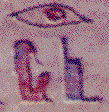


Next: Names of people
Up: A few frequent words
Previous: A few frequent words
Usually, in a class on ancient Egypt, you are taught how to recognize
a few gods: Osiris, Seth, Horus, Re, Amon ...
In fact, the most secure way to recognize a god is to read his name!
So, here are a few current ones:
- Amon
- is usually written

i-men, 
You already know from table 1 that
 is a yod, a semi-consonant like y in English.
Then,
is a yod, a semi-consonant like y in English.
Then,
 is a chessboard for the game called zenet. It
reads men. The
is a n, used both to nicely fit the square
space with the
is a chessboard for the game called zenet. It
reads men. The
is a n, used both to nicely fit the square
space with the
 , and to ensure the reading ``men'', although in
this case there is no ambiguity.
, and to ensure the reading ``men'', although in
this case there is no ambiguity.
The
 is the determinative for gods. It can be ommited
if the name is a caption for a full-size image of the god, in which
case, the said image is itself used as a determinative.
Variants for this determinative are the signs
is the determinative for gods. It can be ommited
if the name is a caption for a full-size image of the god, in which
case, the said image is itself used as a determinative.
Variants for this determinative are the signs
 used for writing the word god, and the hieratic equivalent,
used for writing the word god, and the hieratic equivalent,
 .
.
- Osiris
- Is a name very frequently written. The god himself was
frequently shown, but, as the deceased tended to be called Osiris
themselves, lots of funerary inscriptions feature his name as a
title of the dead.
it is most frequently written:

where the sign
 , a throne, usually used for writing the
consonant
, a throne, usually used for writing the
consonant  , mainly in the word ``place'',
is used for writing the sound
, mainly in the word ``place'',
is used for writing the sound  . The eye
. The eye
 writes the sound
writes the sound
 .
.
A frequent variant is

where the first sign also has the value ``ws''
- Isis
- is spelled

- Anubis
- is written

which you can read with the alphabet:
inpw
You will notice that the frequent ``-is'' ending doesn't appear in
the Egyptian spelling. It's simply a Greek case-ending, added to the
Egyptian name as heard in the last part of the first millennium BC.



Next: Names of people
Up: A few frequent words
Previous: A few frequent words
Serge Rosmorduc
2/26/1998

![]() is the determinative for gods. It can be ommited
if the name is a caption for a full-size image of the god, in which
case, the said image is itself used as a determinative.
Variants for this determinative are the signs
is the determinative for gods. It can be ommited
if the name is a caption for a full-size image of the god, in which
case, the said image is itself used as a determinative.
Variants for this determinative are the signs
![]() used for writing the word god, and the hieratic equivalent,
used for writing the word god, and the hieratic equivalent,
![]() .
.
![]() , a throne, usually used for writing the
consonant
, a throne, usually used for writing the
consonant ![]() , mainly in the word ``place'',
is used for writing the sound
, mainly in the word ``place'',
is used for writing the sound ![]() . The eye
. The eye
![]() writes the sound
writes the sound
![]() .
.![]()
![]()
![]()